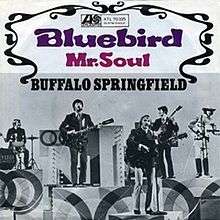Mr. Soul
| "Mr. Soul" | ||||
|---|---|---|---|---|
 | ||||
| Single by Buffalo Springfield | ||||
| from the album Buffalo Springfield Again | ||||
| A-side | "Bluebird" | |||
| Released | June 1967 | |||
| Format | 7-inch single | |||
| Recorded |
| |||
| Genre | ||||
| Length | 2:35 | |||
| Label | Atco | |||
| Writer(s) | Neil Young | |||
| Producer(s) |
| |||
| ISWC | T-070.114.724-1 | |||
| Buffalo Springfield singles chronology | ||||
| ||||
"Mr. Soul" is a song released by the American-Canadian rock band Buffalo Springfield in June 1967, from their second studio album Buffalo Springfield Again.[1]
Background
"Mr. Soul" is about Neil Young's personal problems with fame and disregard towards rock stardom.[2] It was written by Young after experiencing an epilepsy attack after an early show with Buffalo Springfield in San Francisco. Many people in the audience were questioning if it was part of the act.[3] While being a patient at UCLA Medical Center's neuropsychiatry branch, he wrote the song once he was awake and recovering and told to return for further tests.[3] The lyrics had reflected Young's experience, feeling as though he was about to die.[3] Thereupon, he was advised by his doctor to never take LSD or any other hallucinogenic drugs.[3]
Composed on an acoustic twelve-string guitar, the dark and moody song is in double-drop D tuning, which Young used in a number of other songs, such as "Ohio" and "Cinnamon Girl".[4] On the third track of Sugar Mountain - Live At Canterbury House 1968, Young stated that, "A lot of songs take a long time to write. Generally they take an hour and a half, two hours to write. But this one took only five minutes". Young subsequently recorded several other versions of the song, often with marked stylistic changes. The song has been described by music writers as folk rock,[5] psychedelic rock,[6][7] and hard rock.[8]
Cover versions and variations
The song was re-recorded by Young in a synthrock style on his 1982 album Trans, with vocals processed with a vocoder.[9] In addition to this, the song also appears on Young's 1993 Unplugged, Sugar Mountain - Live At Canterbury House 1968 and 1997 Year of the Horse with Crazy Horse. In 2004, Rush covered the song on their cover album of songs from the 1960s, Feedback.[10] The song has also been recorded by the Everly Brothers in December 1968, but was not released until 1984 on their studio album Nice Guys.[11] Other notable cover versions include variations by Diesel Park West, Widespread Panic, the Bluetones and the Icicle Works.[12]
Personnel
- Stephen Stills - guitar (lead), backing vocals
- Neil Young - guitar, lead vocals
- Richie Furay - guitar, backing vocals
- Dewey Martin - drums
- Bruce Palmer - bass guitar
References
- ↑ Domenic Priore (2007). Riot on Sunset Strip: Rock 'n' Roll's Last Stand in Hollywood. Jawbone Press. ISBN 978-1-906002-04-6.
- ↑ Greenwald, Matthew. Song Review by Matthew Greenwald at AllMusic. Retrieved 9 July 2016.
- 1 2 3 4 Johnny Rogan (2001). Neil Young: Zero to Sixty : a Critical Biography. Music Sales Distributed. p. 109. ISBN 978-0-9529540-4-0.
- ↑ McDonough, Jimmy. Shakey: Neil Young's Biography. New York:Anchor, 2003, p. 194.
- ↑ Eric v.d. Luft (21 September 2009). Die at the Right Time!: A Subjective Cultural History of the American Sixties. Gegensatz Press. p. 246. ISBN 978-1-933237-39-8.
- ↑ Jim DeRogatis (1 January 2003). Turn on Your Mind: Four Decades of Great Psychedelic Rock. Hal Leonard Corporation. p. 94. ISBN 978-0-634-05548-5.
- ↑ Tom Moon (28 August 2008). 1,000 Recordings to Hear Before You Die. Workman Publishing Company. p. 130. ISBN 978-0-7611-5385-6.
- ↑ "The Acid Trip: A Complete Guide to Psychedelic Music", Vernon Joynson, (Babylon Books, 1984), ISBN 0907188249 , p.60
- ↑ William Ruhlmann. "Trans - Neil Young | Songs, Reviews, Credits, Awards". AllMusic. Retrieved July 9, 2016.
- ↑ Jurek, Thom. AllMusic Review by Thom Jurek at AllMusic. Retrieved July 9, 2016.
- ↑ Kenneth G. Bielen (2008). The Words and Music of Neil Young. Praeger Publishers. p. 3. ISBN 978-0-275-99902-5.
- ↑ "Versions". Second Hand Songs. Retrieved July 9, 2016.